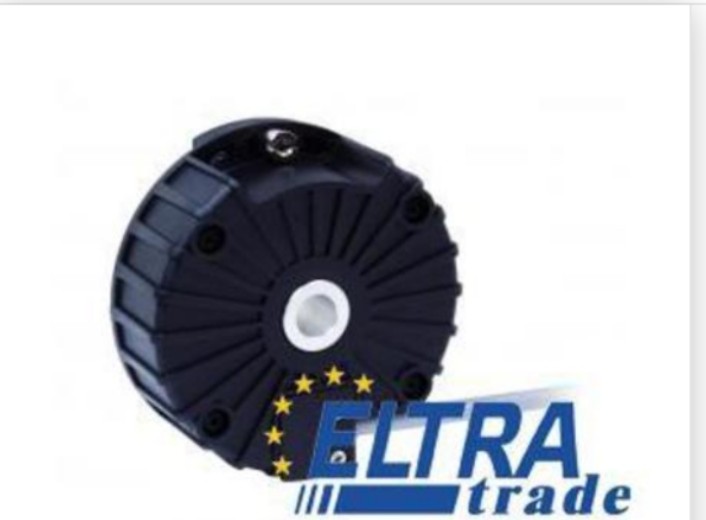An electromechanical device known as an incremental encoder uses rotational or linear motion to generate a series of digital pulses. Rather than giving information about absolute position change, these pulses reflect discrete movement steps. There are two primary types of incremental encoders:
- Rotary encoders: These are fixed on shafts to track angular rotation.
- Linear encoders: They convert a displacement along a guide or linear track.
Significance: In contemporary motion control and automation systems, incremental encoders are essential. Its importance comes from its capacity to offer consistent, precise movement feedback. Incremental encoders enable several important purposes, such as:
- Closed-Loop Control: Encoder data is continually sent to motion controllers. These controllers compare actual position/speed against desired values, making real-time adjustments to maintain accuracy and performance. This closed-loop approach is fundamental in robotics, CNC machining, automated assembly lines, and numerous other applications.
- Synchronization: When multiple motors or axes need to work in unison, incremental encoders ensure perfect timing and coordination. This prevents misalignment, collisions, and product defects in complex systems.
- Error Monitoring & Diagnostics: By comparing encoder feedback with expected motion profiles, systems can detect any slippages, mechanical issues, or deviations from intended trajectories. This allows for early intervention, preventing costly downtime or damage.
- Process Optimization: Encoder data offers valuable insights into machine operation, helping identify potential efficiency improvements and fine-tune motion control parameters.
How Incremental Encoders Work
Principle of Operation
Fundamentally, incremental encoders produce a series of electrical pulses with every movement increment. We refer to the two main output signals as Channel A and Channel B. Using a quadrature approach, 90 degrees of phase shift are applied to these channels.
One can ascertain the direction of motion and the distance traveled by observing the leading and lagging relationship between Channel A and Channel B. For instance, the encoder rotates clockwise if Channel A leads Channel B. Channel B will now lead Channel A due to the direction change.
Every pulse has an exact linear or angular displacement associated with it. The pulses per revolution (PPR) determine the encoder’s resolution.
Types of Incremental Encoders
Now let us look at the two most common kinds of incremental encoders:
- Optical Coders: These work by shining a light source—usually a laser or LED—through a code disk. Transparent and opaque parts make up the pattern on this disk. The light is alternately blocked and transmitted as the disk rotates; photodetectors pick up this pattern and provide the digital pulse outputs.
- Magnetized Encoders: Magnetic encoders use a magnetized disk or strip in conjunction with a magnetic sensor instead of a light-based device. As the disk rotates, the sensor—often a Hall-effect sensor—detects changes in the magnetic field. The encoder’s pulse output is converted into these variances. In general, magnetic encoders are renowned for being resilient in challenging conditions.
Applications of Incremental Encoders
Diverse Industries
The utility of incremental encoders extends throughout many modern industries. Key areas where they play a vital role include:
- Manufacturing: Assembly lines, robotics, material handling, process control
- Robotics: Joint position feedback, navigation, end-effector positioning
- Medical Equipment: Patient positioning systems (surgical tables, imaging equipment), robotic surgical devices, precision drug delivery pumps
- Packaging: Conveyor systems, labeling machinery, filling and dispensing equipment
- Textiles: Fabric tension control, roll length measurement, printing alignment
- Printing: Press roller synchronization, paper feed control, color registration
- Elevators: Floor position sensing, smooth acceleration, and deceleration control
- Renewable Energy: Solar panel tracking, wind turbine positioning
Specific Examples
Let’s explore some specific applications in greater detail:
- Conveyor Belt Systems: Incremental encoders attached to conveyor motors ensure perfect synchronization between multiple belts. This prevents product jams, misalignment, and damage, especially when transferring items between conveyors.
- CNC machines: Each axis (X, Y, Z) has an incremental encoder installed. They give the controller incredibly accurate feedback, allowing the cutting tool or workpiece to be positioned with micrometer precision. This is important for producing complex parts with strict tolerances.
- Patient Positioning Systems: In medical applications such as radiation therapy equipment, surgery tables, or diagnostic imaging, accuracy is critical. The accuracy and consistency of patient placement are greatly impacted by the closed-loop feedback that incremental encoders offer, which is essential for patient comfort and treatment outcomes.
Because incremental encoders can precisely detect motion, there is no end to the automation and control systems that can benefit from their many uses.
Key Disparities between Absolute and Incremental Encoders
Selecting the appropriate encoder type for a motion control application requires a clear understanding of the fundamental distinctions between incremental and absolute encoders.
Position Determination
- Incremental Encoders: Incremental encoders measure changes in position relative to a designated starting point. They inherently provide relative positional information. Visualize this as an odometer tracking mileage without indicating geographic location.
- Absolute Encoders: Absolute encoders determine a unique, identifiable position within their mechanical range. This remains true even after power cycles. These encoders function analogously to a GPS, continually reporting precise coordinates.
Response to Power Interruptions
- Incremental Encoders: Power loss causes an incremental encoder to lose its position reference. Restoration of power mandates a homing procedure, often involving movement to a physical reference point or limit switch, to re-establish absolute position.
- Absolute Encoders: Absolute encoders employ methods to track their position persistently. Upon power restoration, immediate reporting of accurate, absolute position data is possible, eliminating the need for a homing routine.
Comparative Analysis
The following table summarizes key distinctions to aid in selection:
| Feature | Incremental Encoder | Absolute Encoder |
| Position Determination | Relative | Absolute |
| Power Loss Response | Requires re-homing | Retains position |
| Design Complexity | Less complex | More complex |
| Cost | Generally less expensive | More expensive |
| Ideal Applications | Systems prioritizing cost-efficiency, simple position monitoring | Applications demanding immediate position knowledge, those where homing is undesirable or unsafe |
Decision Factors
Key questions when choosing between incremental and absolute encoders:
- Criticality of Absolute Positioning: Is instantaneous, absolute position knowledge essential?
- Homing Feasibility: Can the system reliably implement a homing routine upon startup?
- Downtime Concerns: What are downtime’s potential costs or safety implications due to power loss and re-homing?
- Budgetary Constraints: What are the project’s financial limitations?
Understanding Incremental Encoder Specifications
When selecting an incremental encoder, it’s crucial to consider the following technical specifications to ensure it meets the demands of your application:
Resolution (PPR)
- Definition: Pulses per Revolution (PPR) indicates the number of pulses generated by the encoder for one full rotation of its shaft (or a defined linear distance).
- Accuracy Connection: Higher PPR translates to finer resolution. Therefore, an encoder with a higher PPR can detect smaller changes in position, leading to increased accuracy.
Output Signal Types
- Single-Ended (TTL): This common signaling standard (often 5V) is suitable for short cable runs and electrically clean environments. Its susceptibility to noise is a factor to consider.
- Differential (HTL): Differential signaling (commonly 10-30V) offers superior noise immunity, making it ideal for longer cable lengths or applications with potential electrical interference.
- Advantages: Choose single-ended for simplicity and cost-effectiveness in benign environments. Select the differential when noise immunity is a priority.
Index Pulse (Z Channel)
- Purpose: The index pulse occurs once per revolution, providing a specific reference point within the encoder’s motion range.
- Applications: Index pulses are used for homing procedures, synchronization with external equipment, or defining start/stop positions.
Environmental Factors
- IP Ratings: The Ingress Protection (IP) rating denotes the enclosure’s protection against dust and water intrusion. Select an IP rating appropriate for the environmental conditions (e.g., IP65 for dust and water spray).
- Temperature Range: Encoders are specified for operating temperature ranges. Ensure compatibility with your application’s environment.
- Vibration Resistance: Industrial applications may expose encoders to vibration and shock. Select models rated for the anticipated levels of vibration to ensure reliable performance.
Choosing the Right Specifications
The optimal balance of these specifications depends on your application. Consider:
- Required Accuracy: What level of positional accuracy is needed?
- Environment: Will the encoder be exposed to harsh conditions or electrical noise?
- System Compatibility: Ensure the encoder’s output signals are compatible with your motion controller or other receiving electronics.
By carefully evaluating these specifications, you can select an incremental encoder that delivers the performance, reliability, and longevity necessary for your motion control system.
Components of an Incremental Encoder
Code Disk (or Strip)
- Material: Disks are commonly made from glass (high accuracy), metal (durability), or plastic (cost-effective). Linear encoders employ similar materials fashioned into strips or tapes.
- Patterns: Precisely etched or printed with alternating opaque and transparent lines.
- Radial: Circular pattern for rotary encoders.
- Linear: Parallel lines for linear encoders.
- Accuracy: The fineness and consistency of the code pattern directly influence encoder resolution.
Light Source (Optical Encoders Only)
- LED: The most common and economical light source for optical encoders.
- Laser: Laser is employed in high-precision applications due to its focused beam, enabling finer resolutions.
Magnetic Sensor (Magnetic Encoders Only)
- Hall-effect Sensors: These are widely used in magnetic encoders, detecting variations in the magnetic field created by a magnetized disk or strip.
- Advantages: Hall-effect sensors are robust and tolerant of contamination by dust, oil, and other substances that might interfere with optical encoders.
Signal Processing Circuitry
- Pulse Generation: Electronics within the encoder detect variations in light or magnetic fields, generating the A, B (and sometimes Z) channel output pulses.
- Output Conditioning: This circuitry amplifies signals, provides noise filtering, and may convert them into differential formats for enhanced transmission reliability.
Housing & Shaft
- Housing: The encoder’s enclosure protects sensitive internal components. Materials range from plastic to ruggedized metal, depending on the application.
- Shaft: The encoder shaft connects to the rotating or moving element being monitored. Robust bearings ensure smooth operation with minimal friction.
- Bearing Types: Ball bearings are typical, with heavy-duty bearings found in encoders designed for harsh environments.
- Mounting Options: Common options include flange mount, servo mount, and hollow shaft configurations, providing flexibility for integrating various systems.
Incremental encoders play a vital role in modern motion control. Their ability to precisely monitor position and velocity is crucial for robotics, automation, and countless other applications. Understanding different types, specifications, and how they work is key to choosing the ideal encoder for your system.
The Eltra EH 80P – EF 80 P-C-K is a robust incremental AC servomotor feedback control encoder. It features:
- Compact Size: 80mm diameter for easy integration.
- Scalable Resolution: Available in various resolutions for accuracy matching.
- Commutation Signals (EF Series): Includes Hall-effect phases for optimized motor control.
- Robust Design: Suitable for demanding industrial environments.
Selection Considerations
When selecting an incremental encoder, prioritize:
- Precision: Match the encoder’s resolution to your accuracy needs.
- Environment: Ensure the encoder can withstand temperature, vibration, and contaminants.
- Compatibility: Verify output signals and mechanical interface align with your system.
The Eltra EH 80P – EF 80 P-C-K can be an excellent choice when these factors align with your motion control requirements.


